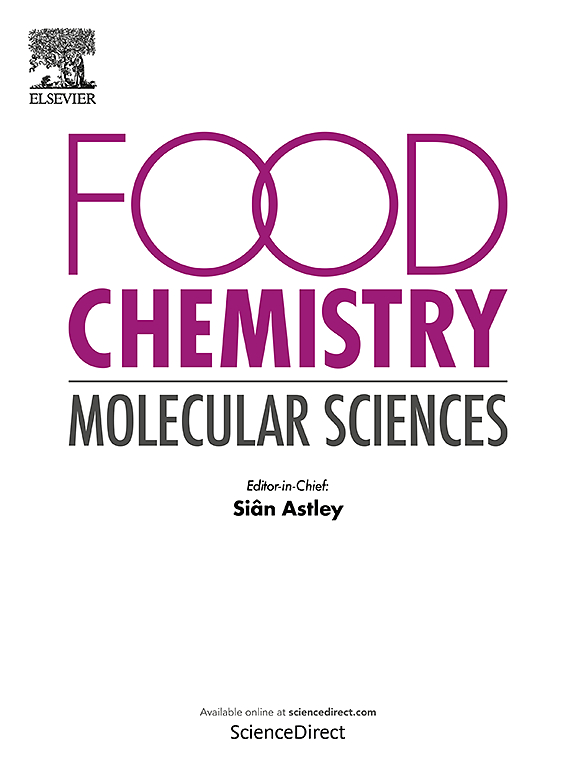Proteomic changes associated with health benefit properties in fresh and preserved mustard greens
IF 4.7
Q2 FOOD SCIENCE & TECHNOLOGY
引用次数: 0
Abstract
Background
Mustard greens are gaining global popularity, but preservation methods like salting and pickling raise specific concerns related to high sodium content and microbial safety. This study conducted a proteomics analysis to identify health-beneficial proteins in mustard greens.
Objective
To explore protein profiles associated with health benefits in fresh and preserved mustard greens.
Methods
Shotgun proteomics combined with LC-MS/MS was applied to identify proteins, followed by statistical analysis using Welch's t-test with Benjamini–Hochberg false discovery rate correction. Unique proteins were visualized with a Venn diagram, annotated using the Gene Ontology (GO) database, and mapped to functional categories with Sankey diagrams. In silico validation of protein stability and gastrointestinal digestion was performed to assess the release of bioactive peptides.
Results
A total of 118 high-confidence proteins were identified, including 27 unique to fresh, 23 to salted, and 22 to pickled mustard greens. Unique proteins in fresh mustard greens were associated with carbohydrate, amino acid, and nucleotide metabolism. Pickled mustard greens had proteins linked to carbohydrate, lipid, glycerol, vitamin, and cofactor metabolism, while salted mustard greens had proteins involved in amino acid, nucleotide, lipid, and glycerol metabolism. In silico digestion revealed that approximately 19–20 % of peptide fragments contained bioactive motifs, predominantly angiotensin-converting enzyme (ACE) and dipeptidyl peptidase-IV (DPP-IV) inhibitory sequences.
Conclusion
Preserved mustard greens contain unique proteins associated with health benefits based on GO annotations, distinguishing their protein profiles from fresh mustard greens. This study provides insights into their functional properties, addressing concerns related to their consumption.
新鲜和腌制芥菜中有益健康的蛋白质组学变化
芥菜在全球越来越受欢迎,但腌制和酸洗等保存方法引起了人们对高钠含量和微生物安全的具体担忧。本研究对芥菜中有益健康的蛋白质进行了蛋白质组学分析。目的探讨新鲜和腌制芥菜中与健康益处相关的蛋白质谱。方法采用shotgun蛋白质组学联合LC-MS/MS对蛋白质进行鉴定,采用Welch’st检验进行统计学分析,并进行Benjamini-Hochberg错误发现率校正。使用Venn图可视化独特的蛋白质,使用基因本体(GO)数据库进行注释,并使用Sankey图映射到功能类别。通过计算机验证蛋白质稳定性和胃肠道消化来评估生物活性肽的释放。结果共鉴定出118个高信度蛋白,其中新鲜芥菜特有27个,腌制芥菜特有23个,腌制芥菜特有22个。新鲜芥菜中的独特蛋白质与碳水化合物、氨基酸和核苷酸代谢有关。腌制芥菜中含有与碳水化合物、脂质、甘油、维生素和辅助因子代谢有关的蛋白质,而腌制芥菜中含有与氨基酸、核苷酸、脂质和甘油代谢有关的蛋白质。硅酶切结果显示,约19 - 20%的肽片段含有生物活性基序,主要是血管紧张素转换酶(ACE)和二肽基肽酶- iv (DPP-IV)抑制序列。结论根据GO注释,保存的芥菜含有与健康有益的独特蛋白质,其蛋白质谱与新鲜芥菜不同。这项研究提供了对其功能特性的见解,解决了与消费相关的问题。
本文章由计算机程序翻译,如有差异,请以英文原文为准。
求助全文
约1分钟内获得全文
求助全文
来源期刊

Food Chemistry Molecular Sciences
Agricultural and Biological Sciences-Food Science
CiteScore
6.00
自引率
0.00%
发文量
83
审稿时长
82 days
期刊介绍:
Food Chemistry: Molecular Sciences is one of three companion journals to the highly respected Food Chemistry.
Food Chemistry: Molecular Sciences is an open access journal publishing research advancing the theory and practice of molecular sciences of foods.
The types of articles considered are original research articles, analytical methods, comprehensive reviews and commentaries.
Topics include:
Molecular sciences relating to major and minor components of food (nutrients and bioactives) and their physiological, sensory, flavour, and microbiological aspects; data must be sufficient to demonstrate relevance to foods and as consumed by humans
Changes in molecular composition or structure in foods occurring or induced during growth, distribution and processing (industrial or domestic) or as a result of human metabolism
Quality, safety, authenticity and traceability of foods and packaging materials
Valorisation of food waste arising from processing and exploitation of by-products
Molecular sciences of additives, contaminants including agro-chemicals, together with their metabolism, food fate and benefit: risk to human health
Novel analytical and computational (bioinformatics) methods related to foods as consumed, nutrients and bioactives, sensory, metabolic fate, and origins of foods. Articles must be concerned with new or novel methods or novel uses and must be applied to real-world samples to demonstrate robustness. Those dealing with significant improvements to existing methods or foods and commodities from different regions, and re-use of existing data will be considered, provided authors can establish sufficient originality.
 求助内容:
求助内容: 应助结果提醒方式:
应助结果提醒方式:


